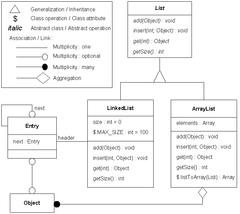Object-modeling technique


The object-modeling technique (OMT) is an object modeling approach for software modeling and designing. It was developed around 1991 by Rumbaugh, Blaha, Premerlani, Eddy and Lorensen as a method to develop object-oriented systems and to support object-oriented programming.Describes Object model or static structure of the system.
OMT was developed as an approach to software development. The purposes of modeling according to Rumbaugh are:[1][2]
- testing physical entities before building them (simulation),
- communication with customers,
- visualization (alternative presentation of information), and
- reduction of complexity.
OMT has proposed three main types of models:
- Object model: The object model represents the static and most stable phenomena in the modeled domain.[3] Main concepts are classes and associations with attributes and operations. Aggregation and generalization (with multiple inheritance) are predefined relationships.[2]
- Dynamic model: The dynamic model represents a state/transition view on the model. Main concepts are states, transitions between states, and events to trigger transitions. Actions can be modeled as occurring within states. Generalization and aggregation (concur-rency) are predefined relationships.[2]
- Functional model: The functional model handles the process perspective of the model, corresponding roughly to data flow diagrams. Main concepts are process, data store, data flow, and actors.[2]
OMT is a predecessor of the Unified Modeling Language (UML). Many OMT modeling elements are common to UML.
Functional Model in OMT: In brief, a functional model in OMT defines the function of the whole internal processes in a model with the help of "Data Flow Diagrams (DFD's)". It details how processes are performed independently.
References
Further reading
- James Rumbaugh, Michael Blaha, William Premerlani, Frederick Eddy, William Lorensen (1990). Object-Oriented Modeling and Design. Prentice Hall. ISBN 0-13-629841-9
- Terry Quatrani, Michael Jesse Chonoles (1996). Succeeding With the Booch and OMT Methods: A Practical Approach. Addison Wesley. ISBN 08053227956
